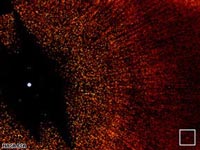 | | This image was snapped by Hubble of one of the four planets, which orbits the star Folmhaut 25 light-years from Earth |
|
The
first-ever pictures of planets outside the solar system have been released
in two studies. The new images, developed by NASA and the Lawrence Livermore
National Laboratory are the first-ever pictures taken from the visible spectrum,
glimpsed by the Gemini North and Keck telescopes on the Mauna Kea mountaintop in
Hawaii. British and American researchers snapped the first ever visible-light
pictures of three extrasolar planets orbiting the star HR8799. HR8799 is about
1.5 times the size of the sun, located 130 light-years away in the Pegasus
constellation. Observers can probably see this star through binoculars,
scientists said.
To identify the planets, researchers compared images of the system, known to
contain planets HF8799b, HF8799c, and HF8799d. In each image faint objects were
detected, and by comparing images from over the years, it was confirmed that
these were the planets in their expected positions and that they orbit their
star in a counterclockwise direction. NASA's Hubble Space Telescope at about the
same time picked up images of a fourth planet, somewhat unexpectedly. The new
planet, Fomalhaut b orbits the bright southern star Fomalhaut, part of the
constellation Piscis Australis (Southern Fish) and is relatively massive --
about three times the size of Jupiter. The planet orbits 10.7 billion miles from
its home star and is approximately 25 light-years from Earth.
FYI, a light year is 5,865,696,000,000 miles (9,460,800,000,000 kilometers).
Even if a probe could travel at the speed of light it would take 25 years to
reach this part of space...